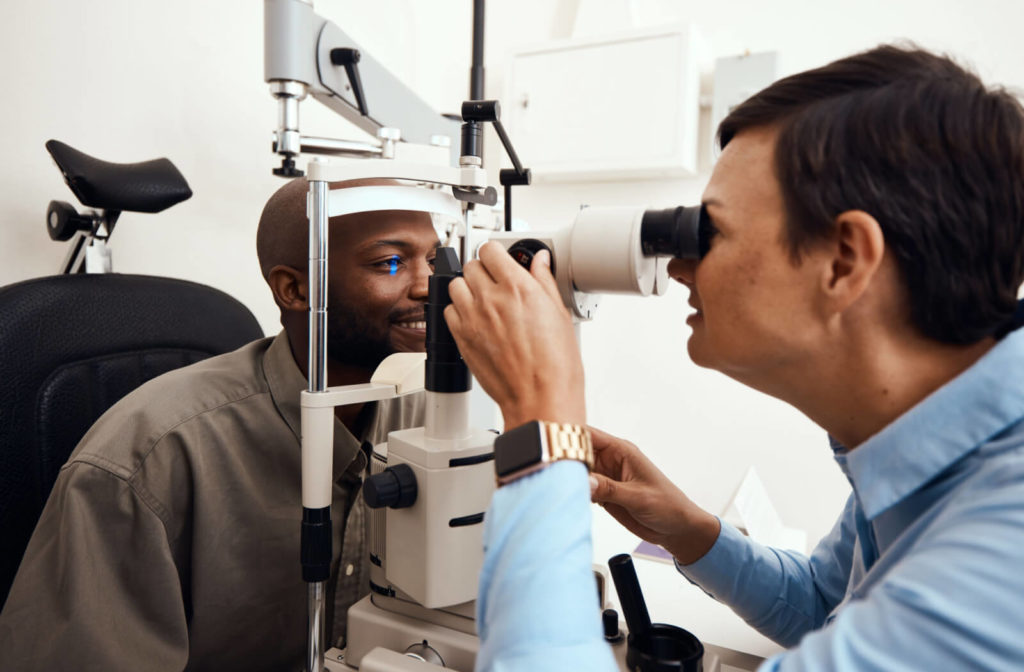You may recall having regular eye exams as a child. However, if you’ve never needed glasses, you’ve probably not seen an optometrist in years. Our eyesight deteriorates as we age, but that isn’t the only reason to have your eyes checked.
Because many eye problems have no symptoms and rarely cause pain, you may be living with a potentially dangerous eye problem and be unaware of it. Adults should have their eyes tested every two years, while children and seniors should have their eyes tested yearly.
What to Expect During an Eye Exam
An eye exam is a simple and quick procedure. First, your eye doctor will lower a large tool covered in dials, switches, and lenses. This is referred to as a phoropter, and it’s most likely the tool that comes to mind when you think of an eye exam.
The optometrist will instruct you to look through the phoropter at a vision chart that is either 20 feet away or reflected in a mirror and appears to be 20 feet away. This chart, which is covered in bold, black letters that are larger at the top and gradually get smaller as they move down, may be familiar to you.
Your doctor will then adjust the power of the lenses by shifting or flipping them back and forth until the letters are visible.
Eye Exams Can Detect Refractive Errors
Refractive errors occur when the shape of your eye fails to bend light correctly, resulting in a blurred image. The three main types of refractive errors are myopia (nearsightedness), hyperopia (farsightedness), and astigmatism.
Myopia
Myopia (nearsightedness) is a common vision condition in which you can see objects close to you but not those further away. It occurs when the shape of your eye causes light rays to bend (refract) incorrectly, focusing images in front of rather than on your retina.
Nearsightedness can appear gradually or suddenly, and it often appears during childhood and adolescence.
Hyperopia
Farsightedness (hyperopia) is a common vision condition where you can see distant objects clearly but nearby objects appear blurry.
Farsightedness is usually present at birth and is hereditary. Eyeglasses or contact lenses can easily correct this condition. Another treatment option is surgery.
Astigmatism
Astigmatism is a common and usually treatable eye curvature that results in blurry distance and close-up vision. This refractive error happens when the curves on the front surface of the eye or the lens inside the eye are misaligned.
Rather than being round, the surface is egg-shaped which causes blurred vision at all distances. Astigmatism is common at birth and can exist alongside nearsightedness or farsightedness.
What Health Issues Can Eye Exams Detect?
The benefits of visiting your ophthalmologist on an annual basis extend far beyond keeping your eyes in good working order.
A thorough examination of the lens, retina, and optic nerve can reveal several systemic disorders, such as high blood pressure and diabetes, sometimes before other symptoms appear.
Lupus
You may have dry eye disease if your eyes are consistently dry. You could, however, have lupus, an inflammatory disease. Lupus is an autoimmune disease where your body attacks healthy tissues.
An optometrist may be concerned about lupus if they notice swelling in the white part of your eyes during an exam.
Multiple Sclerosis (MS)
Multiple sclerosis, a degenerative nervous system disease, can cause optic nerve inflammation. This inflammation is often accompanied by severe blurred vision, painful eye movement, or even double vision.
Thyroid Disorder
If your eyes bulge or protrude from retracting eyelids, your optometrist will suspect hyperthyroidism, which Grave’s Disease frequently causes. This condition affects the tissues and muscles around the eye, and symptoms may include blurry vision, vision loss, or dry eyes.
Blood Pressure Problems
While examining your eyes, an Optometrist may be able to detect high blood pressure. It frequently causes issues with the blood vessels in the back of a person’s eye.
Diabetes
Diabetic retinopathy is distinguished by tiny blood vessels in the retina leaking yellow fluid or blood. Even before a person is diagnosed with diabetes, this disease can manifest itself in eye tissue. Early detection can prevent vision loss and other serious complications.
Book Your Comprehensive Eye Exam Today
Even if your eyes appear to be perfect, you should see your eye doctor regularly. It’s an excellent way to detect and prevent conditions like diabetes, which can progress without your knowledge.
Remember that if you wear glasses or contacts, your prescription will most likely expire yearly, meaning you should see your eye doctor more frequently than every two years. The same is true if you have any other eye health concerns, such as a family history of cataracts.
If you’re due for your next eye exam, book an appointment online today at The Eye Gallery.




